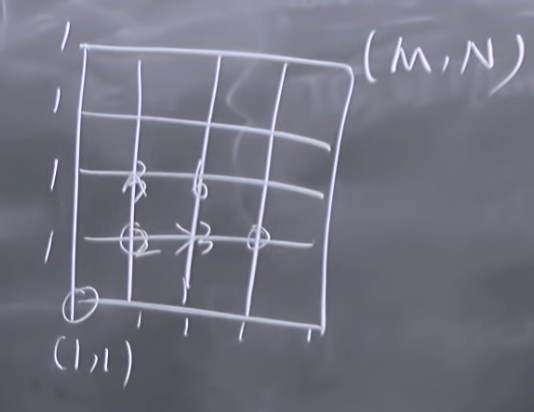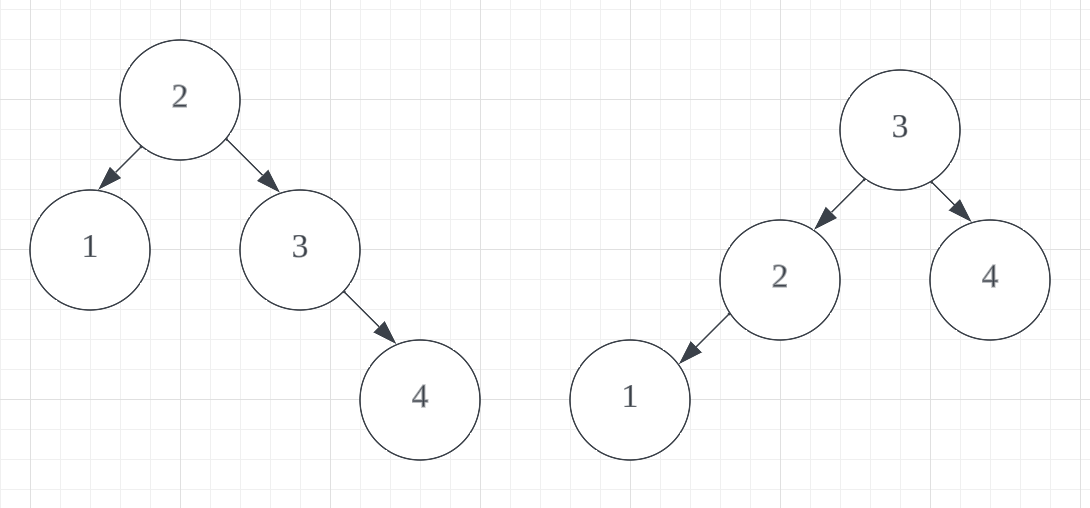6.046 dynamic programming
DP notion:
- Characterize the structure of an optimal solution
- Recursively define the value of an optimal solution based on optimal solutions of subproblems
- Compute the value of an optimal solution in bottom-up fashion (recursion & memoization)
- Construct an optimal solution from the computed information
Introduction¶
The main idea of dp: subtract and solve the subproblem, then reuse the results
Runtime: the number of unique problems+ the amount of merge work
In the recitation, a simple dp example is to solve the number of unique paths from (1, 1) to (M, N).
-

- Subproblem: To the points on the edge, just one path; to the middle points, path to the left point + path the right point
- Runtime: # subproblems = O(MN)
- olc: I misunderstood that the subproblems should start from (M-1, N-1) -> (M, N) which makes solutions hard to get.
Make change example: Make changes for N cents. There are 1=S1 < S2 < … < S_M cent of coin. Find the minimal number of coins needed.
- Subproblem: do a exhaustive search. Pick Si, then MC(N) = min{1 + MC(N-Si)}. N > maximum of subproblems of min{MC(N-Si)}
- Runtime: O(MN).
- It’s similar to knapsack problems (NP-complete). The linear solution here is due to the size of input is log(N), thereby it’s still exponential.
Basic¶
Rectangualar blocks¶
problem: A set of n blocks, {1, 2, …, n}, l_i, w_i, h_i. J on top i, require l_j < l_i, w_j < w_i. Rotating not allowed. Find the maximum height.
? RB(1, 2, …, n)
- olc: the subproblem is whether to put the next block j on top of current (j-1) blocks.
Rec:
Approach 1: exhaustive search
-
RB(1, 2, …, n) = max{h_i + RB(…except i…)} -> messy constraints l, w
-
redefine a compatible set C, then RB(1, 2, …, n) = max{h_i + RB(C_i)}

-
Runtime: O (n^2), # subproblems = n.
-

- what’s in the compatible sets C? How to find C?
- O(n^2): Scan the entire set, find the minimum for each one
- O(nlogn)?
-
Approach 2: weighted interval scheduling
Sorted by length and then width {1, …, n}
RB(1, 2, …, n) = max{(h1 + RB(C_i)), RB(2, …, n)}
Runtime: O(n), # subproblems = n; + O(nlogn), sort; + O(n^2)/O(nlogn) find C set.
Longest Palindromic Seq¶
Input: a sequence of letters -> a string X[1…n], n >=1
Output: (limits) answer >=1
Strategy: L(i, j) is the length of longest palindromic subsequences of X[i…j] for i <= j.
1 | X = 'underqualified' |
Problem 1: How to trace backwards to generate output sequence?
-
ChatGPT: use dp array to trace back and print the result.
1
2
3
4
5
6
7
8
9
10
11def printLPS(i, j):
if i > j:
return ""
if i == j:
return X[i]
if X[i] == X[j]:
return X[i] + printLPS(i+1, j-1) + X[j]
if Dict[i][j-1] > Dict[i+1][j]:
return printLPS(i, j-1)
return printLPS(i+1, j)
print("Longest Palindromic Sequence: ",printLPS(0, len(X)-1))
Problem 2: How to write dp iteratively?
- Iterating: solve subproblems in order of increasing j − i so smaller ones are solved first
Analysis: # subproblems * time to solve each subproblem
- Suppose X[i] are distinct, T(n) is running time on input of length n, T(n) = 2^(n-1)
- 1, n=1
- 2T(n-1), n>1
- But there are only C(n, 2) =
distinct subproblems: (i, j) pairs with i < j. - Given that smaller ones are solved, lookup is O(1)
- memoizing, hash, lookup hash table or recurse
Medium¶
Optimal BSTs¶
Given: keys K1, K2, …, Kn, K1 < K2 < … < Kn, WLOG Ki = i
weights W1, W2, …, Wn (search probability)
Find BST T that minimizes:
- BST invariant: e(i, j) = cost of optimal BST on Ki, K_(i+1)…, Kj. Then the subproblems are {sets < Kr} and {sets > Kr}.
- Want e(1, n).
Enumeration: draw trees when n=2, 3
Greedy solution?: Pick Kr in some greedy fashion, e.g., Wr is maximum. Use the key with maximum Wr as root node.
-
Greedy heuristic: the maximum weight node should have absolute minimum depth.
-
Why greedy does not work?
- Intuition: when the maximum weight node happens to be Kn, the tree is highly unbalanced with all the nodes on the left of root node.
- Nick Davis ex: Kn = 4, weights: 1, 10, 8, 9
-
DP solution?:
- First question: what is the root node? Guess!
- Make a linear number of guesses corresponding root node
- e(i, j) = e(1, r-1) + e(r+1, j), one level below e(i, j)
- e(i, j) =
- wi, if i = j
- MIN(e(i, r-1) + e(r+1, j) + W(i, j)), i<=r<=j
- W(i, j) is sum of the weights from i to j. The weights add up when it goes deeper in recursion.
- Complexity:
. When j-i = 1, e(i, j) is certain and that makes up of C(n, 2) pairs.
Alternating Coins Game¶
Question: Row of n coins of values V1, … , Vn, n is even. In each turn, a player selects either the first or last coin from the row, removes it permanently, and receives the value of
the coin.
Can the first player always win? ->Guaranteed not to lose
Try: 4 42 39 17 25 6
Strategy?
- Compare V1+V3+…+Vn-1 against V2+V4+…+Vn and pick the greater one
- only pick from the chosen subset during the game
Problem: maximize the amount of money won for the player moving first?
Optimal Strategy: assume the opponent always pick best move for it -> modeling in the middle
-
V(i, j): max val the player can win if it is its turn and only coinds Vi, …, Vj remain. V(i, j) =
-
V(i, i), pick i (model the opponent behavior)
-
V(i, i+1), pick the maximum of the two
-
V(i, i+2), V(i, i+3), …
-
-
V(i, j) = max {pick Vi, pick Vj}
- complication: V(i+1, j) is not the board in front of the first player that it can control. It should be the board that gets back after the opponent moves.
- max {<range (i+1, j)> + Vi, <range(i, j-1)> + Vj}
-
V(i+1, j) subproblems with opponent picking
- min {V(i+1, j-1), V(i+2, j)} Vs. the opponent picks Vj or Vi+1
- Certain.
-
V(i, j) = max{min{V(i+1, j-1), V(i+2, j)} + Vi, min{V(i+1, j-2), V(i+1, j-1)} + Vj}
-
Complexity:
All-Pairs Shortest Paths¶
Notations+:
- edge-weighted graph, G = (V, E, w)
is the weights from u to v - Dijkstra for SSSP: O(E + VlgV)
- assume w(u, v) =
if (u, v) E - E =
in sparse case - Bellman-Ford analysis to detect no negative cycles: no negative
Question: given G = (V, E, w), find
-

-
Simple solution: APSP = run SSSP for each of V = |V| * Dijkstra
-
Johnson’s algorithm beats general Bellman-Ford and achives the general Dijkstra complexity bound.
Goal: achieve
DP1¶
- subproblems:
= weight of shortest path u->v using <= m edges - guess: WLOG, guess last edge (x,v)
- recurrence:
= for x V) - base case:
= 0 if u =v; otherwise
- base case:
- acyclic (tological order): for m = 0, 1, …, n-1: for u and v in V:
- original problem: if no negative cycles, then
= = = … (In the worst case, traverse through all vertices without revisiting any vertex)
Analysis
- relaxation step is: if
then - Complexity:
, no better than general Bellman-Ford - relaxation step can be:
= for x V) with overall running time of time
Matrix multiplication¶
- standard matrix multiplication computes
, both n*n matrices. - The fast running time is
comparing to standard algorithm being - connection to shortest paths:
- define
= min, = +, , , V = {1,2, …, n} - computation: semiring is * and +
- complication:
is circle-multiplication of W with itself m times - complexity:
- define
- optimize matrix multiplication: repeated squaring
- ( (
)^2 )^(2…) = , mutliplied by times - assume no negtive cycles, complexity is
, better than general Bellman-Ford
- ( (
- transitive closure:
= 1 if path i->j; 0 otherwise. = OR, = AND - for dense graph
is best
DP2, Floyd-Warshall algorithm¶
- subproblems:
= weight of shortest path u->v whose intermediate vertices {1, 2, …k}. F-W insight on 70s - guess: is k
the path - recurrence:
= - base case:
, not to use any intermediate vertices
- base case:
- acyclic: for k: for u and v in V:
- original problem:
= . Negative weight cycle is negative
Analysis
- complexity:
, compared to DP1the guessing time is constant and same # of subproblems.
Johnson’s algorithm¶
- idea: change weights on edges so no negative weights exist, then run Dijkstra on it. Translate to old weights and get the result.
- steps
- find h: V -> R such that
for all u,v V. - Run Dijkstra on (V, E,
) from s V => get for all u,v V - Compute
by
- find h: V -> R such that
- Proof of correctness: the shortest path is preserved but offset.
- Analysis:
Proof. For any u->v path p in the graph G, say p is v0 -> v1 -> … ->vk, where v0 = u and vk = v.
- Hence …
Problem: How to find the weight function h?
- triangle inequality:
for all (u, v) in V, called a system of difference constraints - application: can think as an event v is happening before event u with constraint w
1. If (V, E, w) has a negative-weight cycle, there exists no solutioon to the above system of difference constraints.
2. If (V, E, w) has no negative-weight cycle, then we can find a solution to the difference constraints.
OLC¶
-
Bottom-up starts with the smallest subproblems first and build up to larger subproblems. Top-down starts with the original problem and breaks it down into smaller subproblems.
-
Bottom up via relaxation means solve subproblems by relaxing edges.
-
DP guess is linear.
